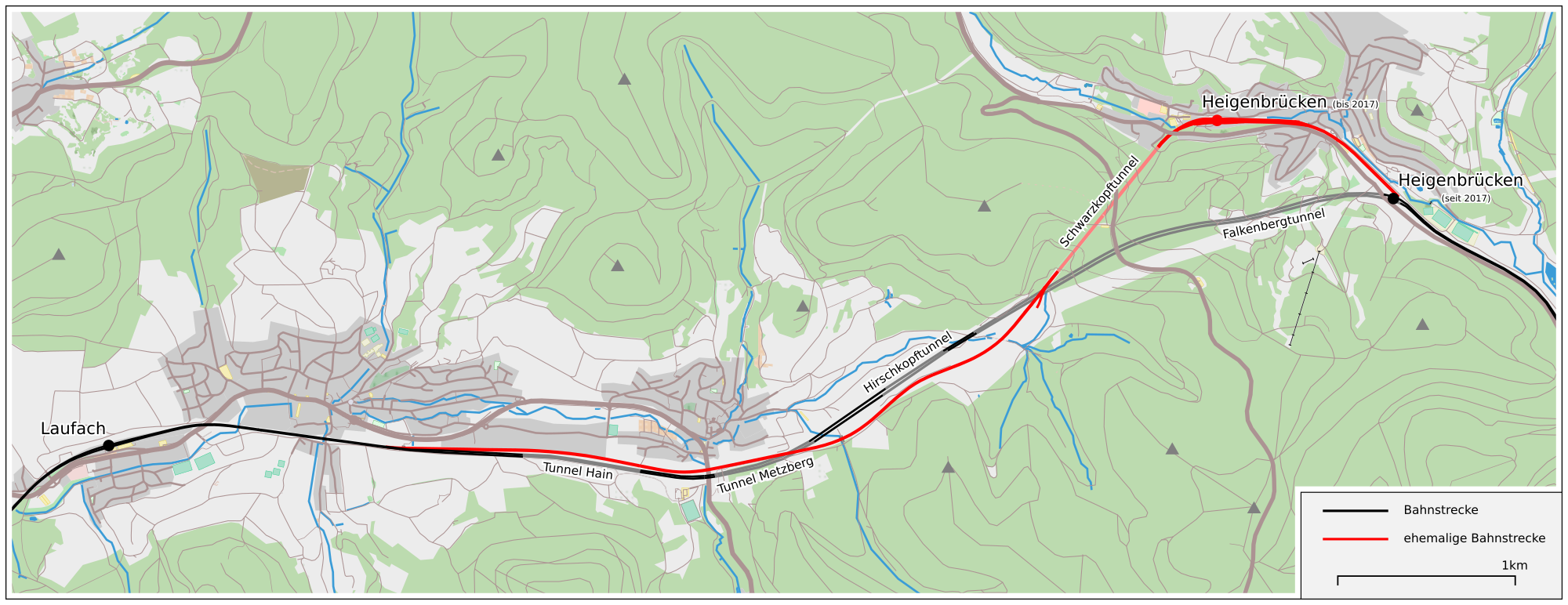|
Ludwig's Western Railway
The Ludwig Western Railway () is a German railway line that was originally funded by the Kingdom of Bavaria. It runs from Bamberg via Würzburg to Aschaffenburg and on into the former " Kurhessian" Hanau. History In the 1840s it was already clear that improvements to the navigation of inland waterways provided by the building of the canal between the rivers Main and Danube, fostered by King Ludwig I of Bavaria, had not triumphed over the railways. After the king had given up his opposition to a main railway line, parliament passed the law for the construction of Ludwig's Western Railway on 23 March 1846, the second main line to be built by the Royal Bavarian State Railways (''Königlich Bayerische Staats-Eisenbahnen''). Operations were first begun on the Hanau–Aschaffenburg section by the Frankfurt-Hanau Railway (''Frankfurt-Hanauer Eisenbahn'') and transferred to the Hessian Ludwigsbahn from 1863. The latter also acquired ownership of the section now running through Prussia ... [...More Info...] [...Related Items...] OR: [Wikipedia] [Google] [Baidu] |
Kahl Am Main
Kahl am Main (, ; officially ''Kahl a.Main'') is a community in the Aschaffenburg (district), Aschaffenburg district in the ''Regierungsbezirk'' of Lower Franconia (''Unterfranken'') in Bavaria, Germany. It has around 7,500 inhabitants. Geography Location Kahl am Main lies 107 m above sea level and includes, at the mouth of the river Kahl (river), Kahl, the lowest-lying point in the state of Bavaria and covers an area of approximately 11 km2. It also lies right on the boundary with Hesse in a favourable location with regards to transport between Aschaffenburg and Hanau (Main-Kinzig-Kreis). Demographics Kahl has a rate of population growth between −0.1% and 0.1%. It also has an aging population with the largest age group being 65 and above in 2014. The average age has increased from 46 in 2005 to 47.5 in 2014. Even though there have been fewer births than deaths consistently since 1975, the city has experiences slight growth due to newcomers. Governance Com ... [...More Info...] [...Related Items...] OR: [Wikipedia] [Google] [Baidu] |
Spessart Ramp
The Spessart Ramp () is a 5.4 km long incline on the Main-Spessart Railway in southern Germany between Laufach at one end and the Schwarzkopf tunnel and Heigenbrücken at the other, with an average incline of 20 ‰. The ramp is part of Ludwig's Western Railway and the section from Würzburg via Aschaffenburg to the state border at Kahl am Main was opened on 1 October 1854 by the Royal Bavarian State Railways. The ramp enabled the difference in height between the Laufach valley and the Lohr valley to be overcome as it crossed the Spessart between Kahl am Main and Aschaffenburg on the one side and Würzburg/Bamberg on the other. In keeping with the philosophy for railway construction at that time it was decided that the way to cope with large differences in height was the construction of a relatively short, steep section of line and to haul trains up the incline with the aid of banking locomotives, whilst the remaining section of the route could be made relatively level. A st ... [...More Info...] [...Related Items...] OR: [Wikipedia] [Google] [Baidu] |
Gemünden Am Main
Gemünden am Main (; officially ''Gemünden a.Main'') is a town in the Main-Spessart, Main-Spessart district in the ''Regierungsbezirk'' of Lower Franconia (''Unterfranken'') in Bavaria, Germany and lies roughly 40 km down the Main (river), Main from Würzburg. Gemünden has around 10,000 inhabitants. Geography Location Gemünden is located in the Main-Spessart, Main-Spessart district in the ''Regierungsbezirk'' of Lower Franconia (''Unterfranken'') in Bavaria, on the Main (river), Main, around 40 km downriver from Würzburg. Within the town, the River Sinn flows into the Franconian Saale, which itself then discharges into the Main. The Main river changes its direction at Gemünden, from northwest to west, marking the transition from the ''Maindreieck'' ("Main Triangle") to the ''Mainviereck'' ("Main quadrangle") near Lohr am Main. Gemünden lies on the ''Birkenhainer Strasse'', an ancient trade road from Lower Franconia to today's Frankfurt Rhine Main Region. Su ... [...More Info...] [...Related Items...] OR: [Wikipedia] [Google] [Baidu] |
River Sinn
The Sinn () is a river that flows through the state of Hesse and the Bavarian province of Lower Franconia in southern Germany. It is about long and is a right, northerly tributary of the Franconian Saale. Course The Sinn emerges in the Franconian Rhön at the foot of the Kreuzberg (Rhön), Kreuzberg near the local subdistrict (''Gemarkung'') of ''Neuwildflecken''. At Zeitlofs on the Hessian-Lower Franconian border it flows into the Schmale Sinn which joins it from the Dammersfeldkuppe to the northeast. Accompanied in places by the Flieden–Gemünden railway, Würzburg−Fulda railway and crossed by the Bundesautobahn 7, A 7 motorway bridge below Riedenberg, the Sinn initially flows in a southwesterly and then in a southerly direction to Gemünden am Main, Gemünden, where it joins the Franconian Saale just under 700 m before the latter river discharges into the River Main (river), Main. Tributaries The tributaries of the Sinn include (in downstream order): Ober ... [...More Info...] [...Related Items...] OR: [Wikipedia] [Google] [Baidu] |
Fränkische Saale
The Franconian Saale (, ) is a 140 km long river in Bavaria, Germany. It is a right-bank tributary of the Main, in Lower Franconia. It should not be confused with the larger Saxon Saale (), which is a tributary of the Elbe River. The Franconian Saale flows through Bad Königshofen, Bad Neustadt, Bad Kissingen, Hammelburg and flows into the Main River in Gemünden am Main. Course Headwaters The Franconian Saale begins in the region of Grabfeld east and southeast of Bad Königshofen at the confluence of two headstreams: *The ''Saalbrunnen'', its northern headstream, rises at the so-called "Source of the Franconian Saale" (''Fränkische Saale Quelle''), 1.7 km east of Alsleben (a district of Trappstadt) on the road to Gompertshausen below the ''Kapellenberg'' at a height of 313 metres above sea level ( NN). The first enclosed wellspring was made of sandstone in the 1940s, it was redesigned in 1973, but its present appearance dates to 1985. Since 198 ... [...More Info...] [...Related Items...] OR: [Wikipedia] [Google] [Baidu] |
Veitshöchheim Bahnhof Königsbau
Veitshöchheim () is a municipality in the district of Würzburg, in Bavaria, Germany. It is situated on the right bank of the Main, northwest of Würzburg. Veitshöchheim has a population just under 10,000. It includes two villages: Veitshöchheim and Gadheim Attractions Schloss Veitshöchheim is located in the town. This summer palace of the Prince-Bishops of Würzburg was built in 1680–82, and was enlarged to its present appearance in 1753 by Balthasar Neumann. The gardens were redesigned for Prince-Bishop Adam Friedrich von Seinsheim (1755–1779), with lakes and waterworks, and filled with hundreds of allegorical sandstone sculptures from the workshops of the court sculptors Ferdinand Tietz and Johann Peter Wagner. Infrastructure Transport Veitshöchheim has a railway station near the Schloss with a former royal pavilion. Partner towns * Rotava, Karlovy Vary Region, Czech Republic * Pont-l'Évêque, Calvados Calvados (, , ) is a brandy from Normandy in F ... [...More Info...] [...Related Items...] OR: [Wikipedia] [Google] [Baidu] |
Frankfurt Am Main
Frankfurt am Main () is the most populous city in the States of Germany, German state of Hesse. Its 773,068 inhabitants as of 2022 make it the List of cities in Germany by population, fifth-most populous city in Germany. Located in the foreland of the Taunus on its namesake Main (river), Main, it forms a continuous conurbation with Offenbach am Main; Frankfurt Rhein-Main Regional Authority, its urban area has a population of over 2.7 million. The city is the heart of the larger Rhine-Main metropolitan region, which has a population of more than 5.8 million and is Germany's Metropolitan regions in Germany, second-largest metropolitan region after the Rhine-Ruhr metropolitan region, Rhine-Ruhr region and the List of EU metropolitan regions by GDP#2021 ranking of top four German metropolitan regions, fourth largest metropolitan region by GDP in the European Union (EU). Frankfurt is one of the ''de facto'' four main capitals of the European Union (alongside Brussels, Luxembourg Cit ... [...More Info...] [...Related Items...] OR: [Wikipedia] [Google] [Baidu] |
Leipzig
Leipzig (, ; ; Upper Saxon: ; ) is the most populous city in the States of Germany, German state of Saxony. The city has a population of 628,718 inhabitants as of 2023. It is the List of cities in Germany by population, eighth-largest city in Germany and is part of the Central German Metropolitan Region. The name of the city is usually interpreted as a Slavic term meaning ''place of linden trees'', in line with many other Slavic placenames in the region. Leipzig is located about southwest of Berlin, in the southernmost part of the North German Plain (the Leipzig Bay), at the confluence of the White Elster and its tributaries Pleiße and Parthe. The Leipzig Riverside Forest, Europe's largest intra-city riparian forest, has developed along these rivers. Leipzig is at the centre of Neuseenland (''new lake district''). This district has Bodies of water in Leipzig, several artificial lakes created from former lignite Open-pit_mining, open-pit mines. Leipzig has been a trade city s ... [...More Info...] [...Related Items...] OR: [Wikipedia] [Google] [Baidu] |
Aschaff
The Aschaff (in its uppermost course: ''Kleinaschaff'') is a river in the northern Spessart in Bavaria, Germany. It is a right tributary of the Main and is long. It begins at the Aschaffquelle near Waldaschaff. Loosely translated the name Aschaff means " ash water". The largest tributary is the Laufach. The river flows mostly parallel to the Bundesautobahn 3 (Motorway). For the construction of the noise barrier A noise barrier (also called a soundwall, noise wall, sound berm, sound barrier, or acoustical barrier) is an exterior structure designed to protect inhabitants of sensitive land use areas from noise pollution. Noise barriers are the most effecti ... there, the river bed was moved and straightened. Now the Aschaff flows in the city of Aschaffenburg. It flows through the districts Damm and Strietwald. In Mainaschaff near the city limits of Aschaffenburg the Aschaff empties into the Main. Tributaries Tributary, Tributaries from source to mouth: Left * Bessenbach ... [...More Info...] [...Related Items...] OR: [Wikipedia] [Google] [Baidu] |



